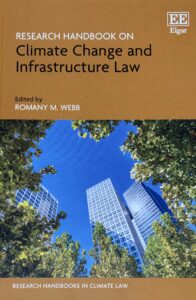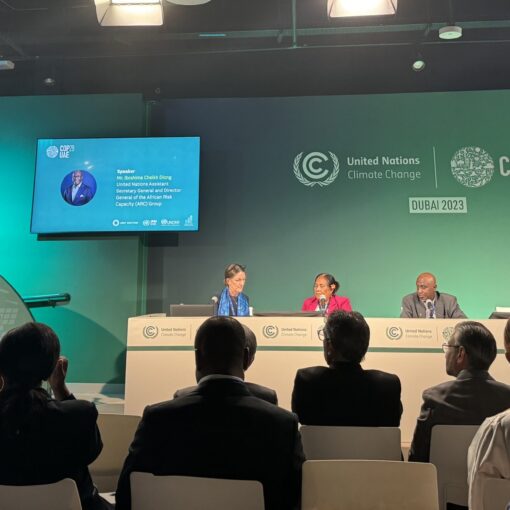 The 30th Conference of the Parties (COP) to the United Nations Framework Convention on Climate Change (UNFCCC) reached a disappointing conclusion on Saturday. Just a few days earlier, things had looked promising. The COP President—Ambassador André Corrêa do Lago of Brazil—had proposed a draft decision recognizing the need for countries to “overcome their dependence on fossil fuels” and requiring the development of a plan to “accelerat[e] action in this critical decade” to transition away from them. Over 80 countries reportedly supported that language but several large oil-producing countries opposed it and, in the end, they won out. The final version of the decision adopted by the UNFCCC Parties includes no mention of fossil fuels.
The 30th Conference of the Parties (COP) to the United Nations Framework Convention on Climate Change (UNFCCC) reached a disappointing conclusion on Saturday. Just a few days earlier, things had looked promising. The COP President—Ambassador André Corrêa do Lago of Brazil—had proposed a draft decision recognizing the need for countries to “overcome their dependence on fossil fuels” and requiring the development of a plan to “accelerat[e] action in this critical decade” to transition away from them. Over 80 countries reportedly supported that language but several large oil-producing countries opposed it and, in the end, they won out. The final version of the decision adopted by the UNFCCC Parties includes no mention of fossil fuels.
For those of us who have worked in the climate space for some time, the outcome was extremely disheartening, but not altogether surprising. It has been well known for decades that the use of fossil fuels is the primary source of climate-damaging greenhouse gas emissions. Global leaders, from United Nations Secretary-General António Guterres to former Presidential Climate Envoy John Kerry, have frequently emphasized the need to rapidly phase out fossil fuels in order to avoid climate catastrophe. But we aren’t doing that. In fact, according to the 2025 Statistical Review of World Energy, fossil fuel use (and associated carbon dioxide emissions) reached a record high in 2024. How can that be? We are constantly hearing that renewable energy is cheaper and better but, still, we remain tied to fossil fuels. In a new book I argue that is, at least in part, due to the infrastructure around which our modern societies are built.
The Research Handbook on Climate Change and Infrastructure Law, which I edited, explains that much of our existing infrastructure was designed around, and locks-in, continued fossil fuel use. In the introduction to the book, I give the example of natural gas pipeline networks which, in the United States alone, “extend approximately 4.3 million kilometers (2.7 miles)—enough to circle the Earth over 100 times. Between 2020 and 2024, new pipelines valued at over $25 billion were developed in the United States. These pipelines are intended to operate for at least 50 years-–i.e., into the 2070s and possibly beyond—and decommissioning them early could have major financial consequences” (internal citations omitted). The pipelines could, in theory, be transitioned to carry other substances that are less climate damaging, such as green hydrogen, but that is likely to require significant and costly upgrades. And, on top of that, there is the cost and complexity of building out the facilities needed to produce green hydrogen and the clean energy systems needed to power them.
This is just one example of a much larger challenge. Effectively mitigating climate change will require the decommissioning of vast amounts of existing infrastructure that supports the production and use of fossil fuels. While doing this, we also need to build out cleaner alternatives, including renewable energy facilities, green buildings, and sustainable transportation systems. And, to further complicate things, both that new infrastructure and any existing facilities that remain must be made resilient to worsening climate impacts.
Right now, in addition to locking in climate damaging activities, existing infrastructure systems also increase our vulnerability to the impacts of climate change. Again, as I explain in the introduction to the book, “the construction of buildings, roads, and other infrastructure results in hundreds of thousands of acres of natural land being paved over with concrete and other impervious materials every year. The expansion of impervious surfaces has changed water run-off patterns, increasing the potential for flooding, especially in coastal cities that are also grappling with climate change-induced sea level rise. The extreme weather brought by climate change also increasingly threatens the water, transportation, energy, and other infrastructure on which cities rely. Many of these infrastructure systems were designed based on historic weather patterns and, as those patterns change, they may become less reliable and more prone to failure” (internal citations omitted).
It is clear, then, that mitigating and adapting to climate change will require a fundamental transformation of global infrastructure. Legal structures will have major implications for whether and how that transformation takes place. The Research Handbook on Climate Change and Infrastructure Law explores how different countries have used law to facilitate, and in some cases hinder, what I describe as “climate-compatible infrastructure development”—that is, infrastructure development that advances climate change mitigation and adaptation goals. The book adopts a broad definition of infrastructure, encompassing not only the human-made physical structures that provide energy, transportation, water, and other services on which modern society relies, but also the naturally occurring systems and processes that support human and ecological health (commonly referred to as “green” or “nature-based” infrastructure).
The book features 21 chapters authored by 34 experts—some legal academics and others practitioners—working on infrastructure-related issues all around the world. The chapters in Part I explore various cross-cutting issues that will be relevant to the development of most, and perhaps all, types of climate compatible infrastructure. These chapters cover:
Chapter 2: Infrastructure Planning in the Climate Era, by Mark Nevitt, Emory University School of Law
Chapter 3: Financing Climate Infrastructure: Opportunities and Challenges, by Ana M. Camelo Vega and Lisa E. Sachs, Columbia University
Chapter 4: Environmental Review for Climate Infrastructure: Essential Safeguard or Barrier to Development?, by Romany M. Webb, Columbia University
Chapter 5: Decarbonization Infrastructure and Indigenous Communities: Consultation, Consent, and Complexity, by David V. Wright, University of Calgary
Chapter 6: Community Benefit Sharing: Lessons for Climate Infrastructure Developers from the Mining Sector, by Kristi Disney Bruckner, Initiative for Responsible Mining Assurance, and Samuel F. de Carvalho, Pace University
The later parts of the book present a series of deep dives into specific types of infrastructure development and associated legal issues. Part II focuses on energy infrastructure and includes chapters on the following topics:
Chapter 7: Decommissioning Oil and Gas Infrastructure in the Energy Transition, by Martin Lockman, William and Mary Law School
Chapter 8: Legal Reforms for a Low-Carbon Electricity Grid: Lessons from the United States, by Adam D. Orford, Fordham University School of Law
Chapter 9: The Path to Clean, Resilient Energy Systems in the Global South: India’s Experience, by Deepa Badrinarayana, Chapman University
Chapter 10: Infrastructure Needs for the Hydrogen Economy: A South Australian Case Study, by Jordie Pettit and Tina Soliman Hunter, Macquarie University, and Alex Wawryk and Kerryn Brent, University of Adelaide Law School
Chapter 11: Developing Infrastructure to Manage Carbon and Realize Negative Emissions: Comparing Experiences Across the EU and US, by Romany M. Webb, Columbia University, and Lena Kannenberg, Ludwig-Maximilians-Universität
Transportation infrastructure is the focus of Part III of the book. The chapters in this part focus on:
Chapter 12: Road Transport in the Age of Climate Change: Advancing Sustainable Solutions in the United States, by Kathryn Zyla, Annie Bennett, and Matthew Goetz, Georgetown Law
Chapter 13: Decarbonizing Freight Transport in the EU: Legal Challenges and Opportunities for Shifting from Road to Rail, by Teodora Serafimova, Sustainable Transport Specialist
Chapter 14: Climate Change and Transportation Infrastructure in Brazil, by Cácia Pimentel, Mackenzie Center for Integrity and Public Policy, and Gabriel Wedy, Universidade do Vale do Rio dos Sinos
Chapter 15: Ensuring Climate Resilient Ports: Regulatory Frameworks to Improve Identification and Management of Climate-Related Risks to Port Infrastructure, by Melanie Baker-Jones and Mark Baker-Jones, Te Whakahaere Āhuarangi Ltd.
Chapter 16: Climate Change and Airport Infrastructure, by Renée Martin-Nagle, A Ripple Effect, and Catherine Juliette Stanley, Howard University.
The final section of the book—Part IV—looks at cities and urban infrastructure, with chapters addressing the following topics:
Chapter 17: Buildings and Climate Change, by Ahmi Dhuna and Katrina M. Wyman, New York University School of Law
Chapter 18: Building Climate-Smart Water and Wastewater Infrastructure: Lessons from South Africa, by Abraham (Abri) Vermeulen PrEng, ACVWater (Pty) Ltd and Lungi Biyela, WaterAid UK
Chapter 19: Climate Change and Waste Management in China, by Feng Peng, Shanghai Academy of Social Sciences, and Wei Xu, The Primary People’s Court of Chongming District of Shanghai Municipality
Chapter 20: Using Planning Law to Advance Urban Green Infrastructure: The Experience of Urban Heat in Sydney, by Paul J. Govind and Peter J. Davies, Macquarie University
Chapter 21: A Growing Need: Advancing Climate Resilience in Emerging Market Cities, by Tom Kerr, World Bank
As indicated in the titles, many of the chapters present case studies, discussing infrastructure development and the governing law in one or a small number of countries. This enables a deeper analysis from which best, and worst, practices and other transferable lessons can be learned. I hope the book proves useful to the many lawyers, policymakers, engineers, scientists, and others who are or will need to be involved in developing the climate compatible infrastructure of the future. My sincere thanks to all of the contributors and the publisher, Edward Elgar, for making it possible.

Romany Webb
Romany Webb is a Research Scholar at Columbia Law School, Adjunct Associate Professor of Climate at Columbia Climate School, and Deputy Director of the Sabin Center for Climate Change Law.



